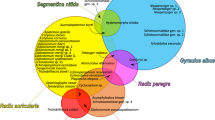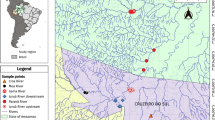Abstract
The nonparametric estimators of species richness are some of the most widely used extrapolation methods in studies of biodiversity. These studies need relative large samples to achieve total diversity (including rare species), and estimators are routinely used to alleviate this problem. In the existing literature, parasite communities have received little attention. In fact, the present study is the first dealing with parasites in invertebrate hosts. Real data on seasonal diversity of larval digeneans in the snails Heleobia conexa and Heleobia australis from Mar Chiquita coastal lagoon (Argentina) were used to evaluate seven nonparametric estimators of species richness, observing the behavior of each method and its ability to estimate the richness using different subsample sizes. In addition, estimated species richness was compared with the previously observed species richness in the parasite component communities of both snail hosts, and the minimum sample size, necessary to include all the observed species of larval digeneans, was estimated using the nonparametric estimators. The bootstrap method had the best overall performance in the two communities. Although this estimator required large subsamples to estimate sample richness, it was in general the least biased and most accurate, and it presented the most similar curve shapes with lack of erratic behavior through the seasons. The results obtained from the comparison between the minimum sample sizes estimated in previous studies of both snail hosts and those suggested by the estimators also support the use of species richness estimators as methods to calculate the minimum sample size in studies of diversity.


Similar content being viewed by others
References
Baltanás A (1992) On the use of some methods for the estimation of species richness. Oikos 65:484–492
Canning-Clode J, Valdivia N, Molis M, Thomason JC, Wahl M (2008) Estimation of regional richness in marine benthic communities: quantifying the error. Limnol Oceanogr Methods 6:580–590
Chazdon RL, Colwell RK, Denslow JS, Guariguata R (1998) Statistical methods for estimating species richness of woody regeneration in primary and secondary rain forests of NE Costa Rica. In: Dallmeier F, Comiskey J (eds) Forest biodiversity research, monitoring and modeling: conceptual background and Old World case studies. Pantheon, Paris, pp 285–309
Colwell RK (2009) EstimateS: statistical estimation of species richness and shared species from samples, version 8.2. User’s guide and application. http://purl.oclc.org/estimates
Colwell RK, Coddington J (1994) Estimating terrestrial biodiversity through extrapolation. Philos Trans R Soc Lond B 345:101–118
Curtis LA, Hubbard KM (1990) Trematode infections in a gastropod host misrepresented by observing shed cercariae. J Exp Mar Biol Ecol 143:131–137
Etchegoin JA (1997) Sistemas parasitarios presentes en la albufera Mar Chiquita. Tesis Doctoral, Facultad de Ciencias Exactas y Naturales, Universidad Nacional de Mar del Plata
Etchegoin JA (2001) Dinámica de los sistemas parasitarios. In: Iribarne OO (ed) Reserva de Biosfera Mar Chiquita: características físicas, biológicas y ecológicas. Editorial Martin, Mar del Plata, pp 227–250
Etchegoin JA, Martorelli SR (1997) Description of a new species of Maritrema (Digenea: Microphallidae) from Mar Chiquita coastal lagoon (Buenos Aires, Argentina) with notes on its life cycle. J Parasitol 83:709–713
Etchegoin JA, Martorelli SR (1998) Nuevos estadios larvales de digeneos parásitos de Heleobia conexa (Mollusca: Hydrobiidae) en Mar Chiquita (Buenos Aires, Argentina). Neotrópica 44:41–50
Faltýnková A, Valtonen ET, Karvonen A (2008) Spatial and temporal structure of the trematode component community in Valvata macrostoma (Gastropa, Prosobranchia). Parasitology 135:1691–1699
Fernández J, Esch GW (1991) Guild structure of larval trematodes in the snail Helisoma anceps: patterns and processes at the individual host level. J Parasitol 77:528–539
Fingerut JT, Zimmer CA, Zimmer RK (2003) Patterns and processes of larval emergence in an estuarine parasite system. Biol Bull 205:110–120
Foggo A, Attrill MJ, Frost MT, Rowden AA (2003) Estimating marine species richness: an evaluation of six extrapolative techniques. Mar Ecol Prog Ser 248:15–26
Gregory RD (1990) Parasites and host geographic range as illustrated by waterfowl. Funct Ecol 4:645–654
Hellman JJ, Fowler GW (1999) Bias, precision and accuracy of four measures of species richness. Ecol Appl 9:824–834
Hortal J, Borges PAV, Gaspar CA (2006) Evaluating the performance of species richness estimators: sensitivity to sample grain size. J Anim Ecol 75:274–287
Hughes JB, Hellmann JJ, Ricketts TH, Bohannan BJM (2001) Counting the uncountable: statistical approaches to estimating microbial diversity. Appl Environ Microbiol 67:4399–4406
Huspeni TC, Hechinger RF, Lafferty KD (2005) Trematodes parasites as estuarine indicators: opportunities, applications, and comparisons with conventional community approaches. In: Bortone S (ed) Estuarine indicators. CRC, Boca Raton, pp 297–314
Kube J, Kube S, Dierschke V (2002) Spatial and temporal variation in the trematode component community of the mudsnail Hydrobia ventrosa in relation to the occurrence of waterfowl as definitive hosts. J Parasitol 88:1075–1086
Kuris AM, Lafferty KD (1994) Community structure: larval trematodes in snail host. Annu Rev Ecol Syst 25:189–217
Lafferty KD, Sammond DT, Kuris AM (1994) Analysis of larval trematode communities. Ecology 75:2275–2285
Mac Nally R, Fleishman E (2002) Using “indicator” species to model species richness: model development and predictions. Ecol Appl 12:79–92
Magurran AE (2004) Ecological diversity and its measurement. Princeton University Press, Princeton
Martorelli SR (1986) Estudio sistemático y biológico de un digeneo perteneciente a la familia Microphallidae Travassos, 1920.I: Microphallus szidati sp. nov. parásito intestinal de Rallus sanguinolentus sanguinolentus (Aves: Rallidae) e Himantopus melanurus (Aves: Recurvirostridae). Rev Iber Parasitol 46:373–378
Martorelli SR (1988) El ciclo biológico de Levinseniella cruzi Travassos, 1920 (Digenea, Microphallidae) parásita de los ciegos cólicos de Rollandia rooland chilensis (Aves, Podicipedidae) e Himantopus melanurus (Aves, Recurvirostridae). Iheringia 68:49–62
Martorelli SR (1989) Estudios parasitológicos en la albufera Mar Chiquita, provincia de Buenos Aires, República Argentina. II. Cercarias (Digenea) parásitas de Heleobia conexa (Mollusca: Hydrobiidae), pertenecientes a las familias Schistosomatidae, Haploporidae y Homalometridae. Neotrópica 35:81–90
Martorelli SR (1990) Estudios parasitológicos en la albufera Mar Chiquita, provincia de Buenos Aires, República Argentina. III: Sobre dos cercarias parásitas de Heleobia conexa (Mollusca: Hydrobiidae) pertenecientes a la superfamilia Echinostomatoidea. Neotrópica 36:55–63
Martorelli SR (1991) El ciclo biológico de Microphallus simillimus (Travassos, 1920), comb. n. (Digenea: Microphallidae), parásito de Heleobia conexa (Mollusca: Hydrobiidae) y de Himantopus melanurus (Aves: Recurvirostridae) en Argentina. Iheringia 71:91–98
Martorelli SR, Etchegoin JA (1996) Cercarias de la superfamilia Opistorchioidea en Heleobia conexa (Mollusca: Hydrobiidae) de la albufera de Mar Chiquita. Neotrópica 42:61–67
McDonald TL, Birkes DS, Urquhart NS (1996) Obtaining species: sample size considerations. Environ Ecol Stat 3:329–347
Melo AS, Froehlich CG (2001) Evaluation of methods for estimating macroinvertebrate species richness using individual stones in tropical streams. Freshw Biol 46:711–721
Merlo MJ (2009) Los sistemas molusco-trematode como indicadores ambientales en la laguna Mar Chiquita, provincia de Buenos Aires. Tesis de Licenciatura. Universidad Nacional de Mar del Plata, Facultad de Ciencias Exactas y Naturales
Moreno CE, Halffter G (2000) Assessing the completeness of bat biodiversity inventories using species accumulation curves. J Appl Ecol 37:149–158
Poulin R (1998) Comparison of three estimators of species richness in parasite component communities. J Parasitol 84:485–490
Poulin R (2006) Global warming and temperature-mediated increases in cercarial emergence in the trematode parasites. Parasitology 132:143–151
Reta R, Martos P, Perillo GME, Piccolo MC, Ferrante A (2001) Características hidrográficas del estuario de la laguna Mar Chiquita. In: Iribarne OO (ed) Reserva de Biósfera Mar Chiquita: características físicas, biológicas y ecológicas. Editorial Martín, Mar del Plata, pp 31–52
Rogowski DL, Stockwell CA (2006) Parasites and salinity: costly in the threatened species. Oecologia 146:615–622
Schoeman DS, Nel R, Soares AG (2008) Measuring species richness on sandy beach transects: extrapolative estimators and their implications for sampling effort. Mar Ecol 29(suppl 1):134–149
Thieltges DW, Jensen KT, Poulin R (2008) The role of biotic factors in the transmission of free-living endohelminth stages. Parasitology 135:407–426
Walther BA, Morand S (1998) Comparative performance of species richness estimation methods. Parasitology 116:395–405
Walther BA, Martin J (2001) Species richness estimation of bird communities how to control for sampling effort? Ibis 143:413–419
Walther BA, Moore JL (2005) The concepts of bias, precision and accuracy, and their use in testing the performance of species richness estimators, with a literature review of estimator performance. Ecography 28:815–829
Walther BA, Cotgreave P, Prince RD, Gregory RD, Clayton DH (1995) Sampling effort and parasite species richness. Parasitol Today 11:306–310
Zelmer DA, Esch GW (1999) Robust estimation of parasite component community richness. J Parasitol 85:592–594
Acknowledgments
The authors gratefully thank Dr. Robert Poulin (University of Otago, New Zealand) for reading an earlier version of the manuscript. This work was supported by the Consejo Nacional de Investigaciones Científicas y Técnicas (CONICET; J.A.E., grant number PIP 114-200801-00001) and Universidad Nacional de Mar del Plata (J.A.E., grant no. EXA 411/08 15/E359). M. J. Merlo and J. A. Etchegoin are members of the Consejo Nacional de Investigaciones Científicas y Técnicas (CONICET).
Author information
Authors and Affiliations
Corresponding author
Rights and permissions
About this article
Cite this article
Merlo, M.J., Parietti, M. & Etchegoin, J.A. Evaluation of species richness estimators in studies of diversity involving two larval digenean communities parasitizing snail hosts. Parasitol Res 107, 1093–1102 (2010). https://doi.org/10.1007/s00436-010-1977-9
Received:
Accepted:
Published:
Issue Date:
DOI: https://doi.org/10.1007/s00436-010-1977-9




